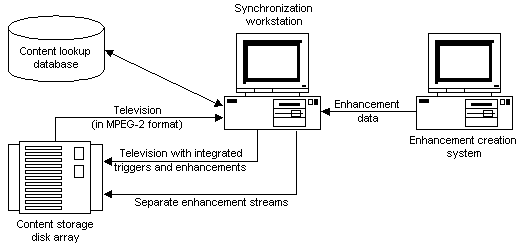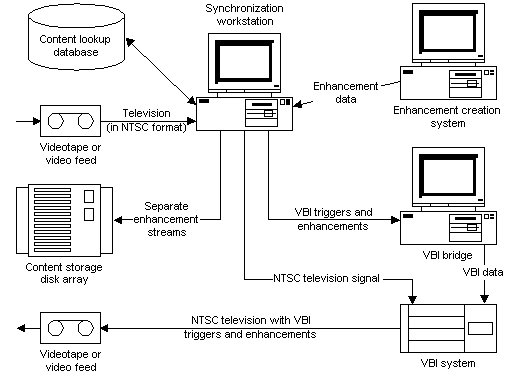
[This is preliminary documentation and subject to change.]
The step of synchronizing television enhancements to shows is primarily relevant for digital enhancements to television and audio programming.
One way to synchronize digital broadcast data with television is to embed hidden triggers in the broadcast data stream. A program running on the broadcast client can check for triggers and display the appropriate digital enhancements when they arrive. To take advantage of this technique, a content provider must insert appropriate triggers in the broadcast data stream and settle on a way to associate each trigger with corresponding enhancement data.
In early implementations of Broadcast Architecture, digital enhancements for television will usually be stored in the vertical blanking interval (VBI) of analog television signals. However, in later implementations of Broadcast Architecture, there may be alternate, richer data steams broadcast in parallel with the television show across digital channels.
Furthermore, even early implementations of Broadcast Architecture may broadcast in advance of a show one or more digital files of subscription data, so these files are available when the show airs. This last possibility is particularly attractive to advertisers because it allows more graphics and information to be transmitted than would fit in the VBI bandwidth available..
Tools to synchronize such ancillary enhancements with television should update the content lookup database so that the link between the television show and the enhancements is recorded in that database. This link can be used to make sure that the enhancements for a particular show get transmitted in time to be used during the show. The following diagrams show such a synchronization process. The first illustration shows how digital data is combined with enhancements. First, an enhancement creation system sends the enhancements to the synchronization workstation. This workstation uses information in the content lookup database to combine the television data from the content storage array with the enhancement data. Then the synchronization workstation returns the combined data and any separate enhancement streams, to the content storage array.

In following illustration enhancements are synchronized with analog television. The enhancement creation system, synchronization workstation, and content lookup database function in the same way as the previous illustration. The difference is in the source of the video data and how the final output is stored. With analog video, only the separate enhancement streams are stored in the content storage disk array. The synchronization workstation gets video from a video tape or other video feed and passes it to a VBI system. At the same time, the synchronization workstation passes the VBI triggers and enhancements to a VBI bridge that, in turn, passes the data to the VBI system. The VBI system combines the video with the VBI data and outputs the NTSC television with triggers and enhancements.
